Nurses' Responses to Deteriorating Patients: Review of Literature
VerifiedAdded on 2020/02/05
|18
|4461
|54
Report
AI Summary
This report provides a comprehensive review of nurses' responses to deteriorating patients, analyzing published studies and research articles. It explores various aspects of emergency care, including the role of Medical Emergency Teams (METs), the use of early warning scores, and the impact of simulation programs on nurses' decision-making. The report examines factors that influence nurses' ability to recognize and respond to patient deterioration, such as uncertainty, anxiety, and the need for swift action. It also discusses the importance of training, debriefing, and the implementation of standardized protocols to improve patient outcomes. The review highlights gaps in the literature and emphasizes the need for further research on the challenges nurses face in emergency situations and the strategies that can enhance their competence and confidence in handling critical cases. The report concludes with a discussion of the common themes and recommendations for improving the quality of care for deteriorating patients.
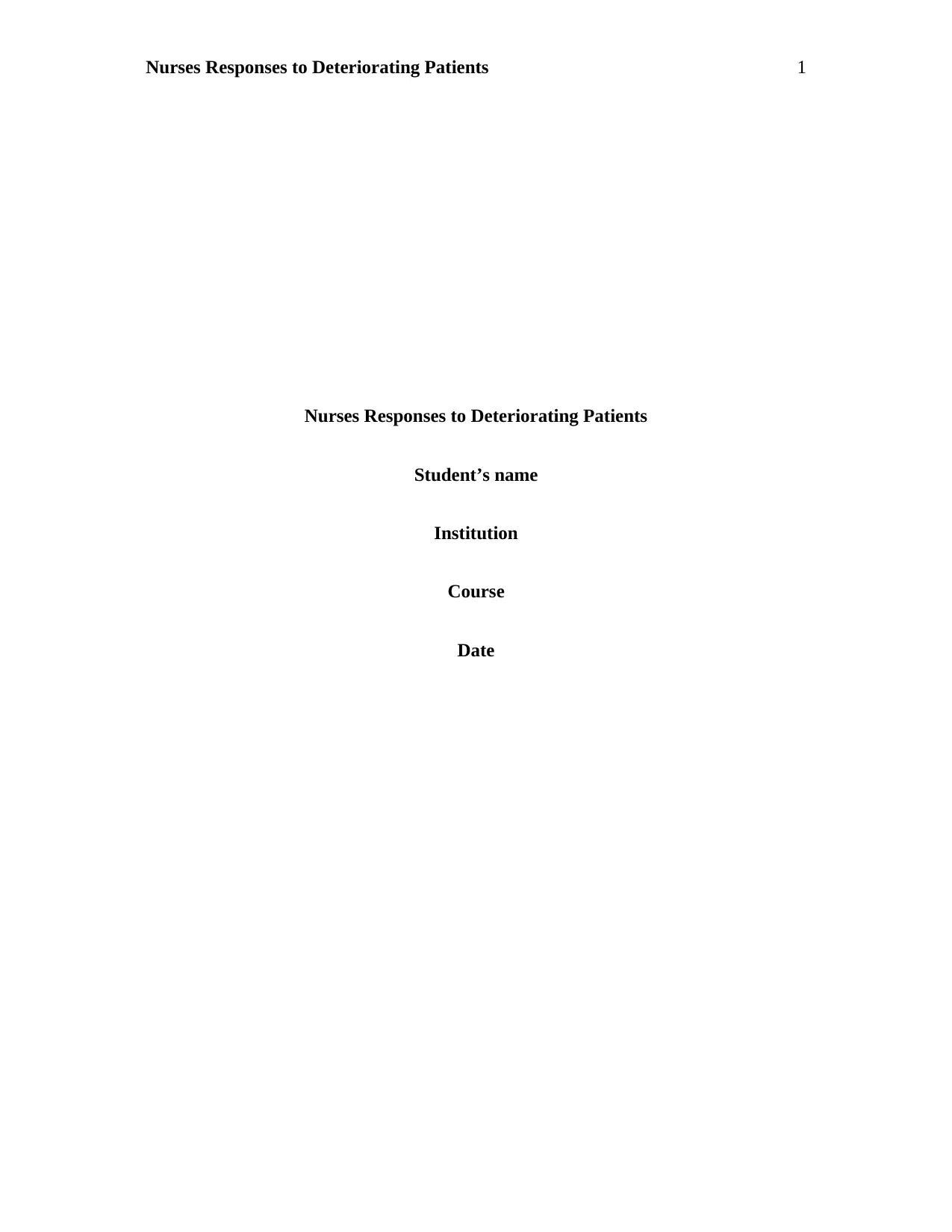
Nurses Responses to Deteriorating Patients 1
Nurses Responses to Deteriorating Patients
Student’s name
Institution
Course
Date
Nurses Responses to Deteriorating Patients
Student’s name
Institution
Course
Date
Paraphrase This Document
Need a fresh take? Get an instant paraphrase of this document with our AI Paraphraser

Nurses Responses to Deteriorating Patients 2
Contents
Aim..............................................................................................................................................................2
Methods......................................................................................................................................................3
Background..................................................................................................................................................3
Literature Review........................................................................................................................................4
Nurses Responses to Emergencies..............................................................................................................4
Nurses Calling in the Medical Emergency Team......................................................................................4
Summoning the Medical Emergency Teams............................................................................................6
Do Nurses Respond Swiftly Enough?.......................................................................................................7
The National Early Warning Score or NEWS............................................................................................9
Survey to Understand Responding to Emergencies...............................................................................10
Nurse and Simulation Programs................................................................................................................12
Simulation of Deterioration of a Patient and Nurse Responses.............................................................12
Graduate Nurses Making Decisions in Emergencies..............................................................................13
The FIRST2 ACT Program.......................................................................................................................15
RAPIDS or “Rescuing A Patient in Deteriorating Situations”..................................................................16
Patient Deterioration Simulation Experiences.......................................................................................17
Discussion..................................................................................................................................................19
Conclusion.................................................................................................................................................22
Appendix A: Tabulation of research studies that analyzed responses of nurses to the deteriorating
patient.......................................................................................................................................................23
Bibliography...............................................................................................................................................29
Contents
Aim..............................................................................................................................................................2
Methods......................................................................................................................................................3
Background..................................................................................................................................................3
Literature Review........................................................................................................................................4
Nurses Responses to Emergencies..............................................................................................................4
Nurses Calling in the Medical Emergency Team......................................................................................4
Summoning the Medical Emergency Teams............................................................................................6
Do Nurses Respond Swiftly Enough?.......................................................................................................7
The National Early Warning Score or NEWS............................................................................................9
Survey to Understand Responding to Emergencies...............................................................................10
Nurse and Simulation Programs................................................................................................................12
Simulation of Deterioration of a Patient and Nurse Responses.............................................................12
Graduate Nurses Making Decisions in Emergencies..............................................................................13
The FIRST2 ACT Program.......................................................................................................................15
RAPIDS or “Rescuing A Patient in Deteriorating Situations”..................................................................16
Patient Deterioration Simulation Experiences.......................................................................................17
Discussion..................................................................................................................................................19
Conclusion.................................................................................................................................................22
Appendix A: Tabulation of research studies that analyzed responses of nurses to the deteriorating
patient.......................................................................................................................................................23
Bibliography...............................................................................................................................................29

Nurses Responses to Deteriorating Patients 3
Nurses Responses to Deteriorating Patients
Aim
In this review paper, I have aimed to identify first the studies published in academic journals
regarding nurses’ responses to deteriorating patients. I have provided the summaries of the
articles selected from the web, relevant to my search, in simple language, yet capturing the main
essence of the articles. The gaps have been identified in the literature reviewed and a discussion
of the common themes is given at the end of the paper. The main question that is analyzed is
whether nurses are competent enough to handle emergencies in which a patient is deteriorating.
The methods to enhance such skills required by nurses and nursing students alike have also been
discussed.
Methods
The terms “nurse’s response to patient’s deterioration” were used, as I searched Google Scholar
for peer-reviewed papers. From the search, I obtained 10 peer-reviewed articles, which I have
attempted to give in simple terms, while maintaining the main points articulated in the original
research article.
Background
In the last decade, a lot of attention was paid to recognizing and responding to patients who were
deteriorating in the hospital. Observations by many scholars revealed that patient’s deterioration
was often not recognized and responded to, leading to the manifestation of several adverse
patient outcomes. These adverse outcomes could have been avoided, if the nurse in-charge had
had the confidence and surety about summoning help while confronting emergencies such as
rapidly deteriorating patients in the ward or the intensive care unit.
Nurses Responses to Deteriorating Patients
Aim
In this review paper, I have aimed to identify first the studies published in academic journals
regarding nurses’ responses to deteriorating patients. I have provided the summaries of the
articles selected from the web, relevant to my search, in simple language, yet capturing the main
essence of the articles. The gaps have been identified in the literature reviewed and a discussion
of the common themes is given at the end of the paper. The main question that is analyzed is
whether nurses are competent enough to handle emergencies in which a patient is deteriorating.
The methods to enhance such skills required by nurses and nursing students alike have also been
discussed.
Methods
The terms “nurse’s response to patient’s deterioration” were used, as I searched Google Scholar
for peer-reviewed papers. From the search, I obtained 10 peer-reviewed articles, which I have
attempted to give in simple terms, while maintaining the main points articulated in the original
research article.
Background
In the last decade, a lot of attention was paid to recognizing and responding to patients who were
deteriorating in the hospital. Observations by many scholars revealed that patient’s deterioration
was often not recognized and responded to, leading to the manifestation of several adverse
patient outcomes. These adverse outcomes could have been avoided, if the nurse in-charge had
had the confidence and surety about summoning help while confronting emergencies such as
rapidly deteriorating patients in the ward or the intensive care unit.
⊘ This is a preview!⊘
Do you want full access?
Subscribe today to unlock all pages.

Trusted by 1+ million students worldwide

Nurses Responses to Deteriorating Patients 4
The ability of nurses to appropriately recognize and respond to clinical scenarios that present
with deteriorating patients determines the patient outcomes. There has not been much research
done on why and how nurses falter and fail to save the deteriorating patient. Thus, there is the
essential need for a literature review delving into the factors that undermine nurses’ reactions to
emergencies and the factors that prevent them from acting swiftly in such conditions. This is
indeed a clinical problem of great complexity.
A deteriorating parent is defined as “A patient who moves from one clinical state to a worse
clinical state which increases their individual risk of morbidity, including organ dysfunction,
protracted hospital stay, disability or death (Jones et al. 2013).”
Literature Review
Nurses Responses to Emergencies
Nurses Calling in the Medical Emergency Team
The authors (Cioffi, 2000) of this study aimed at collecting the responses and descriptions of
nurses, who were providing emergency care to patients deteriorating, by calling in the medical
emergency team. The interviews were held with nurses belonging to 3 wards in a peripheral
hospital and 4 wards in a teaching hospital in Australia. The institutional ethical committee of the
hospital approved of the study. About 32 nurses of the seven wards comprised the study
popriution. They had had experience of calling in the MET for at least five years.
Unstructured interviews were held with the participating nurses who audiotaped their responses.
Their anonymity was maintained as they were assigned codes. The nurses recorded their
experiences in calling in the MET.
The ability of nurses to appropriately recognize and respond to clinical scenarios that present
with deteriorating patients determines the patient outcomes. There has not been much research
done on why and how nurses falter and fail to save the deteriorating patient. Thus, there is the
essential need for a literature review delving into the factors that undermine nurses’ reactions to
emergencies and the factors that prevent them from acting swiftly in such conditions. This is
indeed a clinical problem of great complexity.
A deteriorating parent is defined as “A patient who moves from one clinical state to a worse
clinical state which increases their individual risk of morbidity, including organ dysfunction,
protracted hospital stay, disability or death (Jones et al. 2013).”
Literature Review
Nurses Responses to Emergencies
Nurses Calling in the Medical Emergency Team
The authors (Cioffi, 2000) of this study aimed at collecting the responses and descriptions of
nurses, who were providing emergency care to patients deteriorating, by calling in the medical
emergency team. The interviews were held with nurses belonging to 3 wards in a peripheral
hospital and 4 wards in a teaching hospital in Australia. The institutional ethical committee of the
hospital approved of the study. About 32 nurses of the seven wards comprised the study
popriution. They had had experience of calling in the MET for at least five years.
Unstructured interviews were held with the participating nurses who audiotaped their responses.
Their anonymity was maintained as they were assigned codes. The nurses recorded their
experiences in calling in the MET.
Paraphrase This Document
Need a fresh take? Get an instant paraphrase of this document with our AI Paraphraser
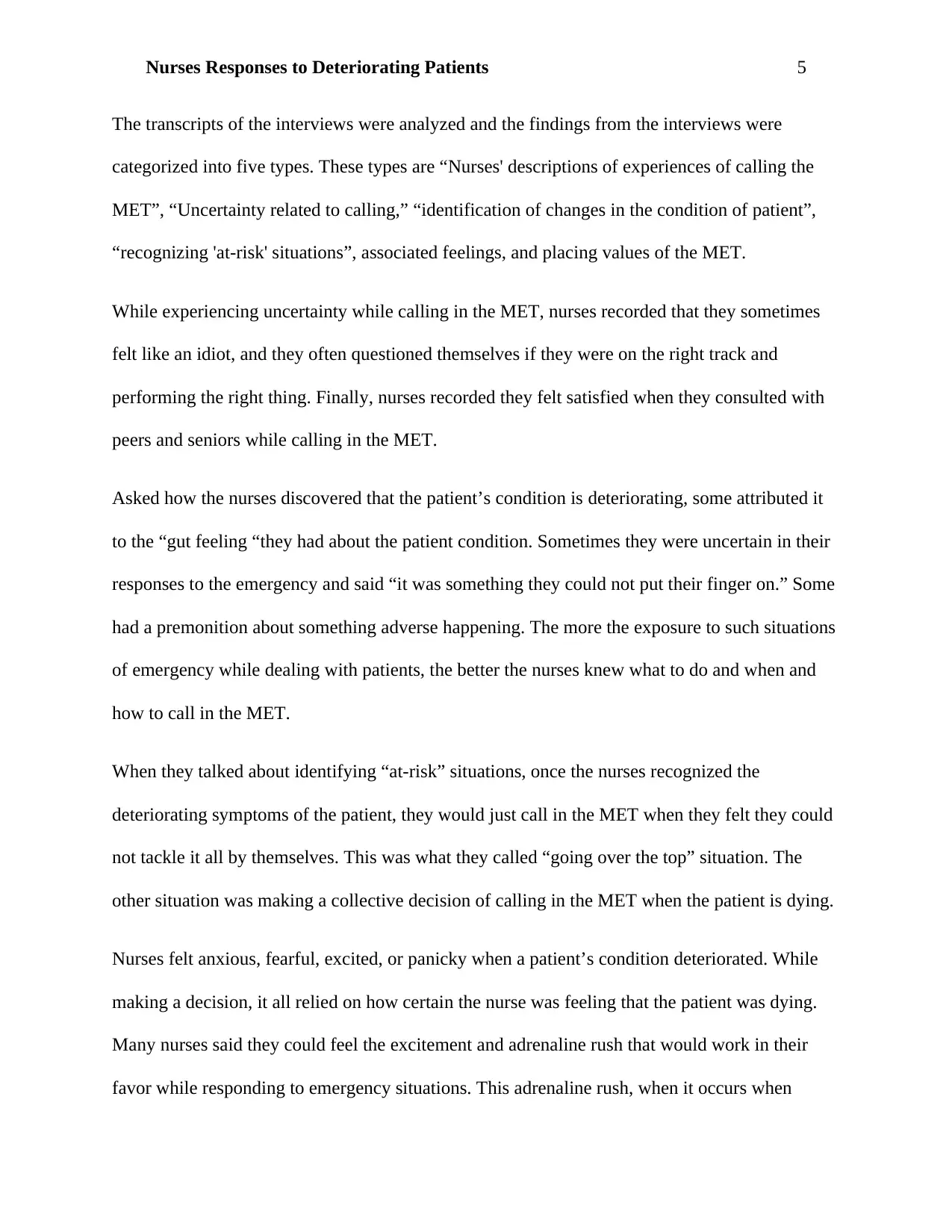
Nurses Responses to Deteriorating Patients 5
The transcripts of the interviews were analyzed and the findings from the interviews were
categorized into five types. These types are “Nurses' descriptions of experiences of calling the
MET”, “Uncertainty related to calling,” “identification of changes in the condition of patient”,
“recognizing 'at-risk' situations”, associated feelings, and placing values of the MET.
While experiencing uncertainty while calling in the MET, nurses recorded that they sometimes
felt like an idiot, and they often questioned themselves if they were on the right track and
performing the right thing. Finally, nurses recorded they felt satisfied when they consulted with
peers and seniors while calling in the MET.
Asked how the nurses discovered that the patient’s condition is deteriorating, some attributed it
to the “gut feeling “they had about the patient condition. Sometimes they were uncertain in their
responses to the emergency and said “it was something they could not put their finger on.” Some
had a premonition about something adverse happening. The more the exposure to such situations
of emergency while dealing with patients, the better the nurses knew what to do and when and
how to call in the MET.
When they talked about identifying “at-risk” situations, once the nurses recognized the
deteriorating symptoms of the patient, they would just call in the MET when they felt they could
not tackle it all by themselves. This was what they called “going over the top” situation. The
other situation was making a collective decision of calling in the MET when the patient is dying.
Nurses felt anxious, fearful, excited, or panicky when a patient’s condition deteriorated. While
making a decision, it all relied on how certain the nurse was feeling that the patient was dying.
Many nurses said they could feel the excitement and adrenaline rush that would work in their
favor while responding to emergency situations. This adrenaline rush, when it occurs when
The transcripts of the interviews were analyzed and the findings from the interviews were
categorized into five types. These types are “Nurses' descriptions of experiences of calling the
MET”, “Uncertainty related to calling,” “identification of changes in the condition of patient”,
“recognizing 'at-risk' situations”, associated feelings, and placing values of the MET.
While experiencing uncertainty while calling in the MET, nurses recorded that they sometimes
felt like an idiot, and they often questioned themselves if they were on the right track and
performing the right thing. Finally, nurses recorded they felt satisfied when they consulted with
peers and seniors while calling in the MET.
Asked how the nurses discovered that the patient’s condition is deteriorating, some attributed it
to the “gut feeling “they had about the patient condition. Sometimes they were uncertain in their
responses to the emergency and said “it was something they could not put their finger on.” Some
had a premonition about something adverse happening. The more the exposure to such situations
of emergency while dealing with patients, the better the nurses knew what to do and when and
how to call in the MET.
When they talked about identifying “at-risk” situations, once the nurses recognized the
deteriorating symptoms of the patient, they would just call in the MET when they felt they could
not tackle it all by themselves. This was what they called “going over the top” situation. The
other situation was making a collective decision of calling in the MET when the patient is dying.
Nurses felt anxious, fearful, excited, or panicky when a patient’s condition deteriorated. While
making a decision, it all relied on how certain the nurse was feeling that the patient was dying.
Many nurses said they could feel the excitement and adrenaline rush that would work in their
favor while responding to emergency situations. This adrenaline rush, when it occurs when
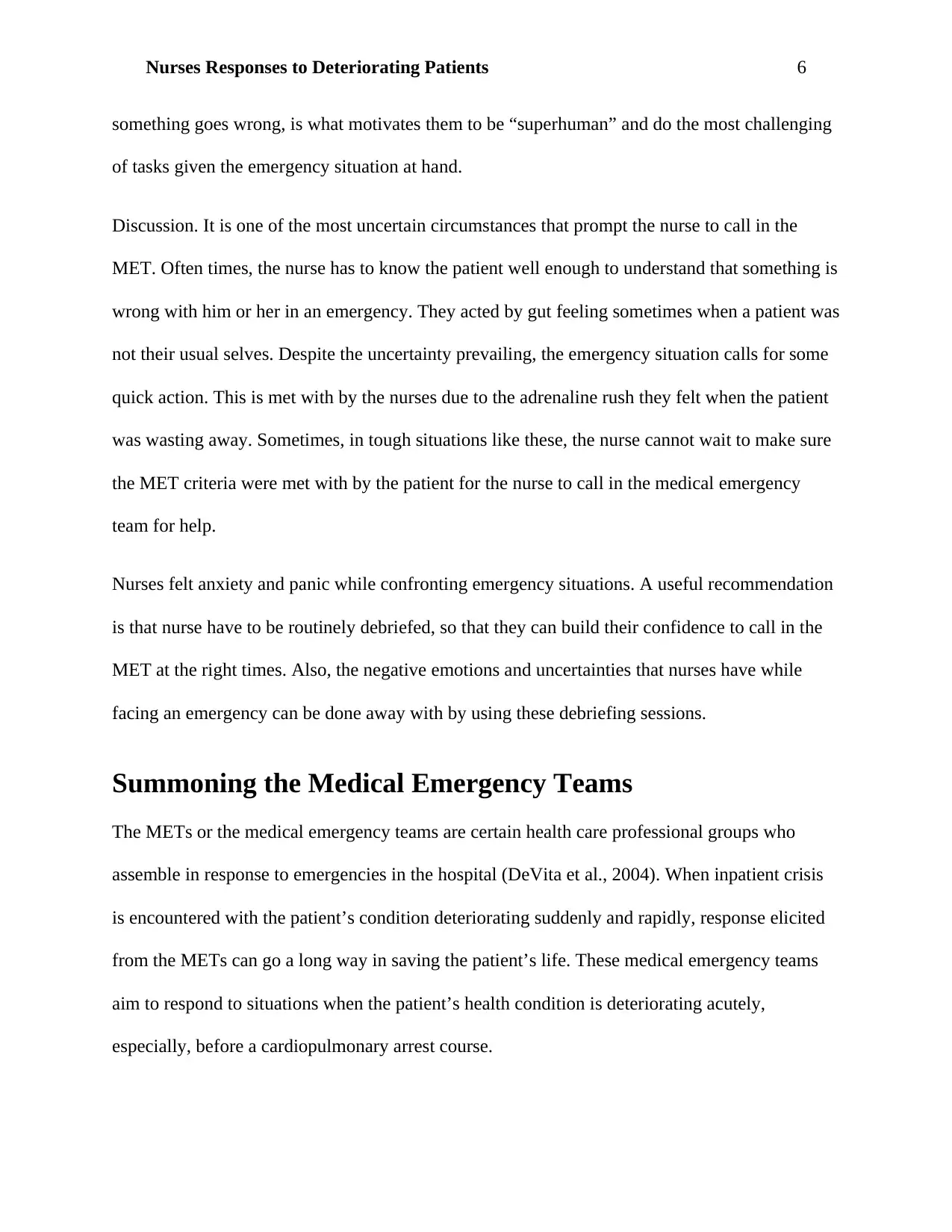
Nurses Responses to Deteriorating Patients 6
something goes wrong, is what motivates them to be “superhuman” and do the most challenging
of tasks given the emergency situation at hand.
Discussion. It is one of the most uncertain circumstances that prompt the nurse to call in the
MET. Often times, the nurse has to know the patient well enough to understand that something is
wrong with him or her in an emergency. They acted by gut feeling sometimes when a patient was
not their usual selves. Despite the uncertainty prevailing, the emergency situation calls for some
quick action. This is met with by the nurses due to the adrenaline rush they felt when the patient
was wasting away. Sometimes, in tough situations like these, the nurse cannot wait to make sure
the MET criteria were met with by the patient for the nurse to call in the medical emergency
team for help.
Nurses felt anxiety and panic while confronting emergency situations. A useful recommendation
is that nurse have to be routinely debriefed, so that they can build their confidence to call in the
MET at the right times. Also, the negative emotions and uncertainties that nurses have while
facing an emergency can be done away with by using these debriefing sessions.
Summoning the Medical Emergency Teams
The METs or the medical emergency teams are certain health care professional groups who
assemble in response to emergencies in the hospital (DeVita et al., 2004). When inpatient crisis
is encountered with the patient’s condition deteriorating suddenly and rapidly, response elicited
from the METs can go a long way in saving the patient’s life. These medical emergency teams
aim to respond to situations when the patient’s health condition is deteriorating acutely,
especially, before a cardiopulmonary arrest course.
something goes wrong, is what motivates them to be “superhuman” and do the most challenging
of tasks given the emergency situation at hand.
Discussion. It is one of the most uncertain circumstances that prompt the nurse to call in the
MET. Often times, the nurse has to know the patient well enough to understand that something is
wrong with him or her in an emergency. They acted by gut feeling sometimes when a patient was
not their usual selves. Despite the uncertainty prevailing, the emergency situation calls for some
quick action. This is met with by the nurses due to the adrenaline rush they felt when the patient
was wasting away. Sometimes, in tough situations like these, the nurse cannot wait to make sure
the MET criteria were met with by the patient for the nurse to call in the medical emergency
team for help.
Nurses felt anxiety and panic while confronting emergency situations. A useful recommendation
is that nurse have to be routinely debriefed, so that they can build their confidence to call in the
MET at the right times. Also, the negative emotions and uncertainties that nurses have while
facing an emergency can be done away with by using these debriefing sessions.
Summoning the Medical Emergency Teams
The METs or the medical emergency teams are certain health care professional groups who
assemble in response to emergencies in the hospital (DeVita et al., 2004). When inpatient crisis
is encountered with the patient’s condition deteriorating suddenly and rapidly, response elicited
from the METs can go a long way in saving the patient’s life. These medical emergency teams
aim to respond to situations when the patient’s health condition is deteriorating acutely,
especially, before a cardiopulmonary arrest course.
⊘ This is a preview!⊘
Do you want full access?
Subscribe today to unlock all pages.

Trusted by 1+ million students worldwide
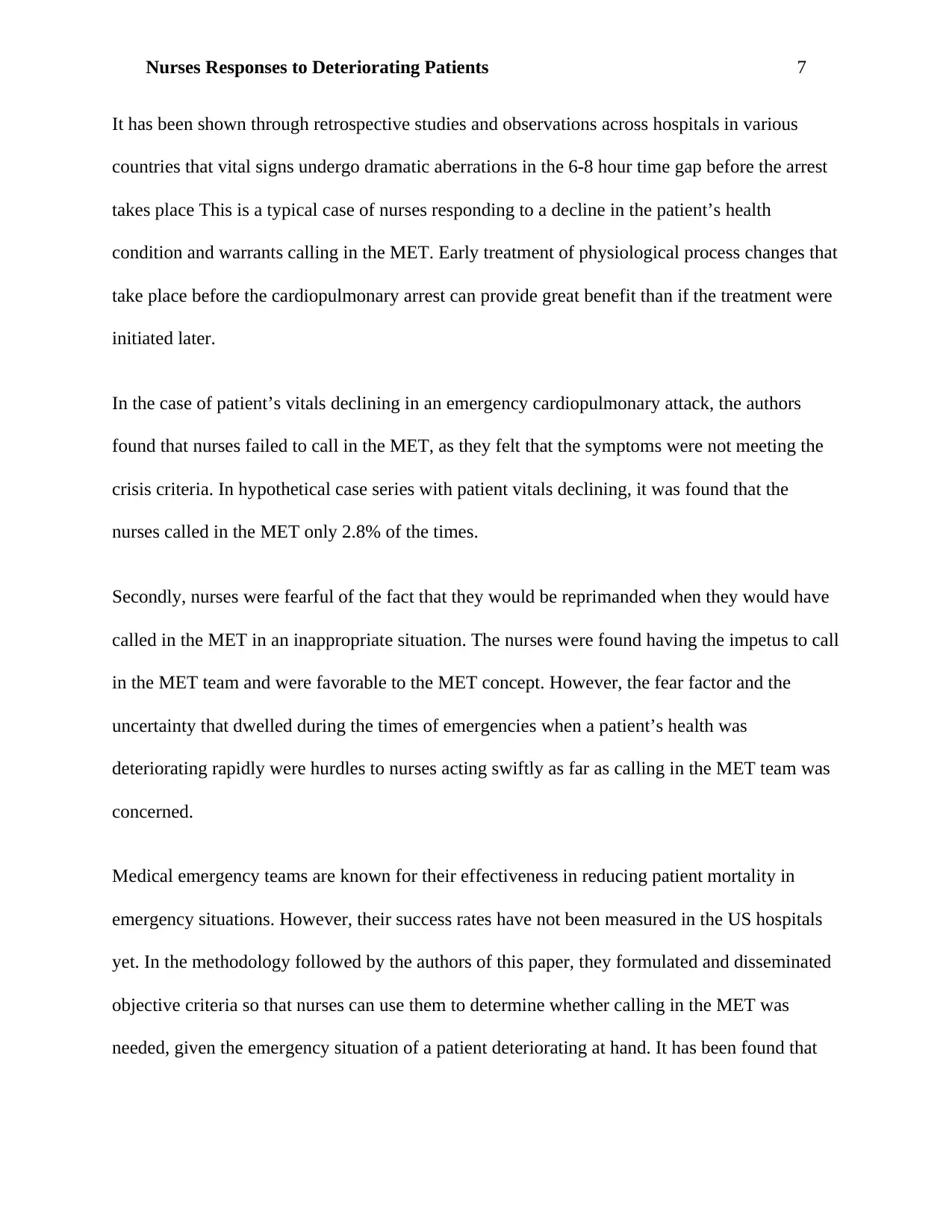
Nurses Responses to Deteriorating Patients 7
It has been shown through retrospective studies and observations across hospitals in various
countries that vital signs undergo dramatic aberrations in the 6-8 hour time gap before the arrest
takes place This is a typical case of nurses responding to a decline in the patient’s health
condition and warrants calling in the MET. Early treatment of physiological process changes that
take place before the cardiopulmonary arrest can provide great benefit than if the treatment were
initiated later.
In the case of patient’s vitals declining in an emergency cardiopulmonary attack, the authors
found that nurses failed to call in the MET, as they felt that the symptoms were not meeting the
crisis criteria. In hypothetical case series with patient vitals declining, it was found that the
nurses called in the MET only 2.8% of the times.
Secondly, nurses were fearful of the fact that they would be reprimanded when they would have
called in the MET in an inappropriate situation. The nurses were found having the impetus to call
in the MET team and were favorable to the MET concept. However, the fear factor and the
uncertainty that dwelled during the times of emergencies when a patient’s health was
deteriorating rapidly were hurdles to nurses acting swiftly as far as calling in the MET team was
concerned.
Medical emergency teams are known for their effectiveness in reducing patient mortality in
emergency situations. However, their success rates have not been measured in the US hospitals
yet. In the methodology followed by the authors of this paper, they formulated and disseminated
objective criteria so that nurses can use them to determine whether calling in the MET was
needed, given the emergency situation of a patient deteriorating at hand. It has been found that
It has been shown through retrospective studies and observations across hospitals in various
countries that vital signs undergo dramatic aberrations in the 6-8 hour time gap before the arrest
takes place This is a typical case of nurses responding to a decline in the patient’s health
condition and warrants calling in the MET. Early treatment of physiological process changes that
take place before the cardiopulmonary arrest can provide great benefit than if the treatment were
initiated later.
In the case of patient’s vitals declining in an emergency cardiopulmonary attack, the authors
found that nurses failed to call in the MET, as they felt that the symptoms were not meeting the
crisis criteria. In hypothetical case series with patient vitals declining, it was found that the
nurses called in the MET only 2.8% of the times.
Secondly, nurses were fearful of the fact that they would be reprimanded when they would have
called in the MET in an inappropriate situation. The nurses were found having the impetus to call
in the MET team and were favorable to the MET concept. However, the fear factor and the
uncertainty that dwelled during the times of emergencies when a patient’s health was
deteriorating rapidly were hurdles to nurses acting swiftly as far as calling in the MET team was
concerned.
Medical emergency teams are known for their effectiveness in reducing patient mortality in
emergency situations. However, their success rates have not been measured in the US hospitals
yet. In the methodology followed by the authors of this paper, they formulated and disseminated
objective criteria so that nurses can use them to determine whether calling in the MET was
needed, given the emergency situation of a patient deteriorating at hand. It has been found that
Paraphrase This Document
Need a fresh take? Get an instant paraphrase of this document with our AI Paraphraser
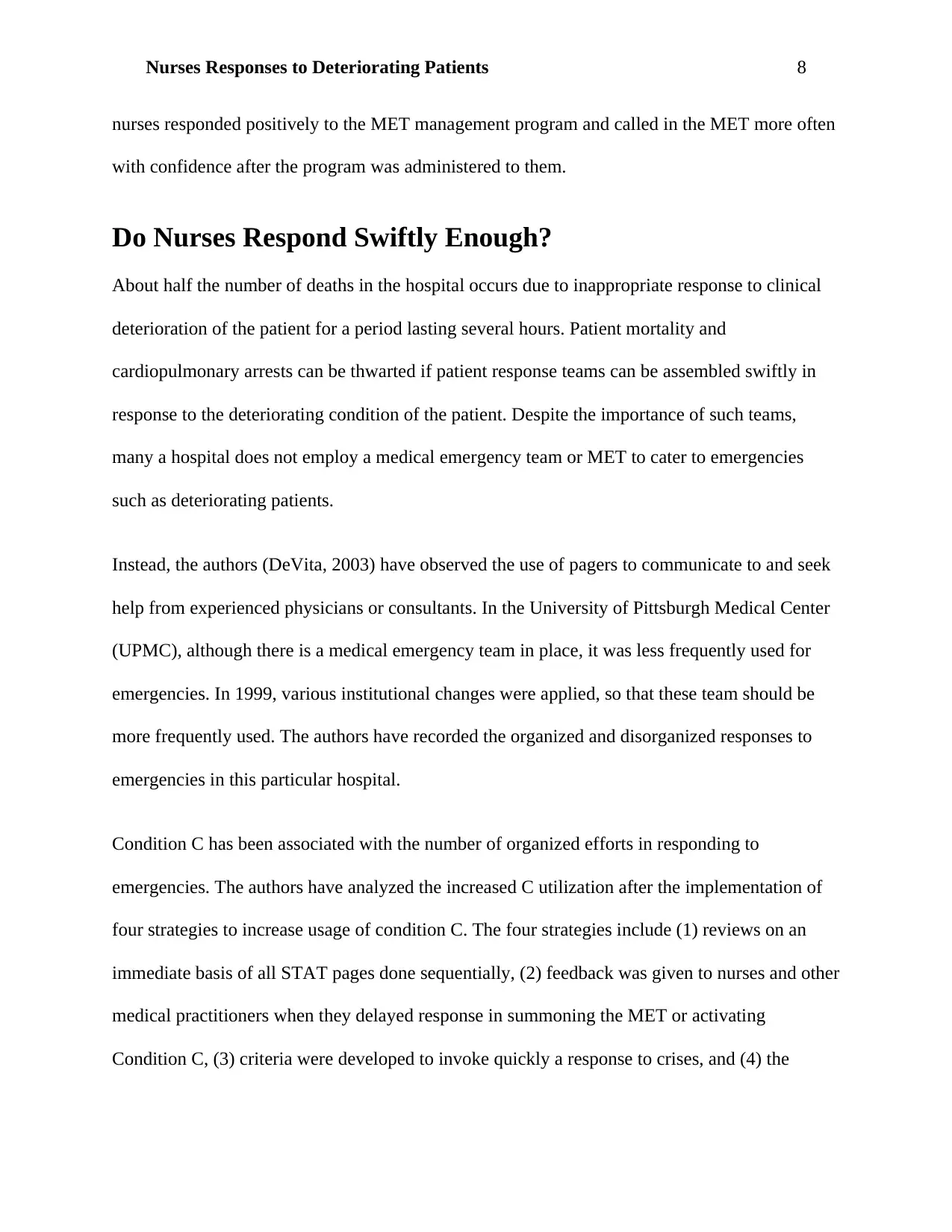
Nurses Responses to Deteriorating Patients 8
nurses responded positively to the MET management program and called in the MET more often
with confidence after the program was administered to them.
Do Nurses Respond Swiftly Enough?
About half the number of deaths in the hospital occurs due to inappropriate response to clinical
deterioration of the patient for a period lasting several hours. Patient mortality and
cardiopulmonary arrests can be thwarted if patient response teams can be assembled swiftly in
response to the deteriorating condition of the patient. Despite the importance of such teams,
many a hospital does not employ a medical emergency team or MET to cater to emergencies
such as deteriorating patients.
Instead, the authors (DeVita, 2003) have observed the use of pagers to communicate to and seek
help from experienced physicians or consultants. In the University of Pittsburgh Medical Center
(UPMC), although there is a medical emergency team in place, it was less frequently used for
emergencies. In 1999, various institutional changes were applied, so that these team should be
more frequently used. The authors have recorded the organized and disorganized responses to
emergencies in this particular hospital.
Condition C has been associated with the number of organized efforts in responding to
emergencies. The authors have analyzed the increased C utilization after the implementation of
four strategies to increase usage of condition C. The four strategies include (1) reviews on an
immediate basis of all STAT pages done sequentially, (2) feedback was given to nurses and other
medical practitioners when they delayed response in summoning the MET or activating
Condition C, (3) criteria were developed to invoke quickly a response to crises, and (4) the
nurses responded positively to the MET management program and called in the MET more often
with confidence after the program was administered to them.
Do Nurses Respond Swiftly Enough?
About half the number of deaths in the hospital occurs due to inappropriate response to clinical
deterioration of the patient for a period lasting several hours. Patient mortality and
cardiopulmonary arrests can be thwarted if patient response teams can be assembled swiftly in
response to the deteriorating condition of the patient. Despite the importance of such teams,
many a hospital does not employ a medical emergency team or MET to cater to emergencies
such as deteriorating patients.
Instead, the authors (DeVita, 2003) have observed the use of pagers to communicate to and seek
help from experienced physicians or consultants. In the University of Pittsburgh Medical Center
(UPMC), although there is a medical emergency team in place, it was less frequently used for
emergencies. In 1999, various institutional changes were applied, so that these team should be
more frequently used. The authors have recorded the organized and disorganized responses to
emergencies in this particular hospital.
Condition C has been associated with the number of organized efforts in responding to
emergencies. The authors have analyzed the increased C utilization after the implementation of
four strategies to increase usage of condition C. The four strategies include (1) reviews on an
immediate basis of all STAT pages done sequentially, (2) feedback was given to nurses and other
medical practitioners when they delayed response in summoning the MET or activating
Condition C, (3) criteria were developed to invoke quickly a response to crises, and (4) the
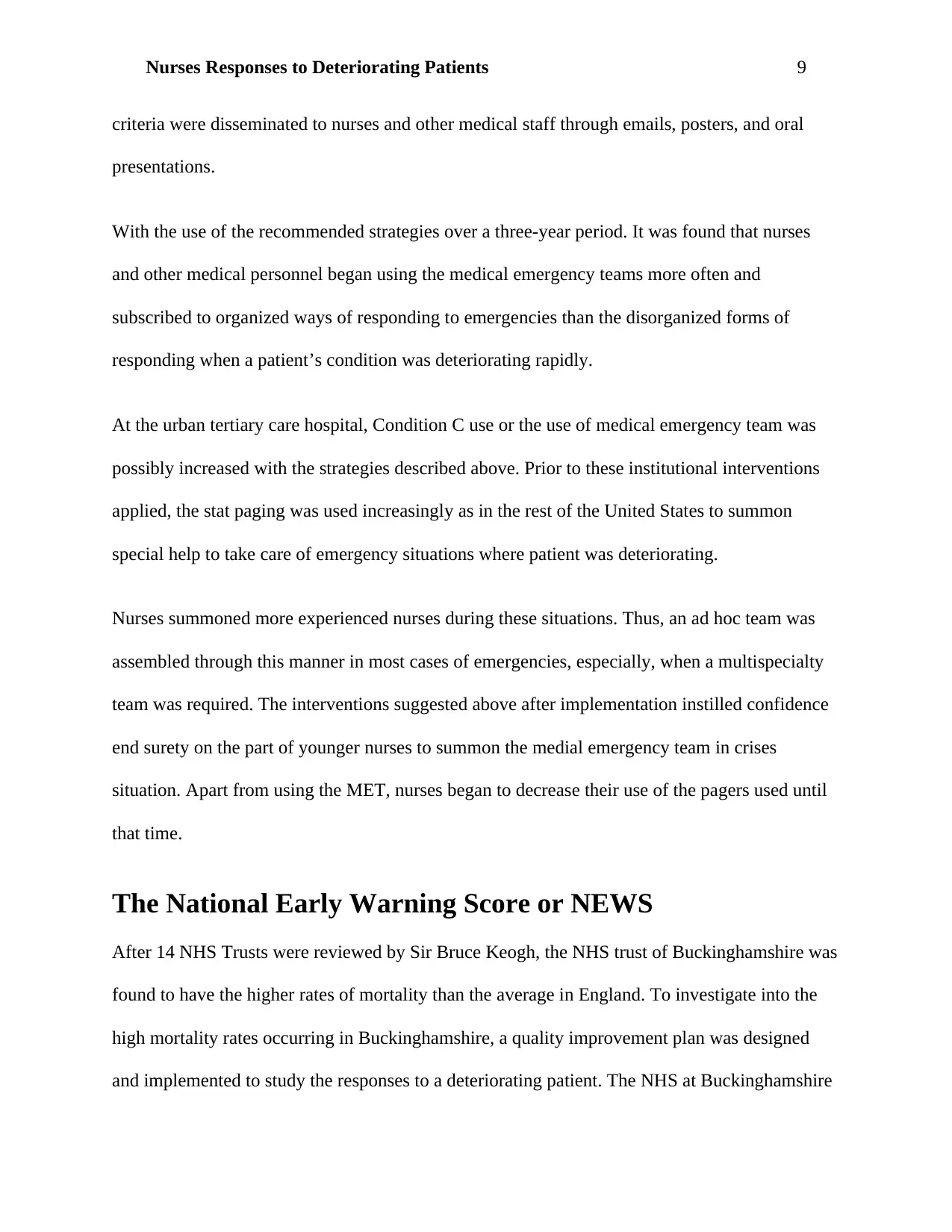
Nurses Responses to Deteriorating Patients 9
criteria were disseminated to nurses and other medical staff through emails, posters, and oral
presentations.
With the use of the recommended strategies over a three-year period. It was found that nurses
and other medical personnel began using the medical emergency teams more often and
subscribed to organized ways of responding to emergencies than the disorganized forms of
responding when a patient’s condition was deteriorating rapidly.
At the urban tertiary care hospital, Condition C use or the use of medical emergency team was
possibly increased with the strategies described above. Prior to these institutional interventions
applied, the stat paging was used increasingly as in the rest of the United States to summon
special help to take care of emergency situations where patient was deteriorating.
Nurses summoned more experienced nurses during these situations. Thus, an ad hoc team was
assembled through this manner in most cases of emergencies, especially, when a multispecialty
team was required. The interventions suggested above after implementation instilled confidence
end surety on the part of younger nurses to summon the medial emergency team in crises
situation. Apart from using the MET, nurses began to decrease their use of the pagers used until
that time.
The National Early Warning Score or NEWS
After 14 NHS Trusts were reviewed by Sir Bruce Keogh, the NHS trust of Buckinghamshire was
found to have the higher rates of mortality than the average in England. To investigate into the
high mortality rates occurring in Buckinghamshire, a quality improvement plan was designed
and implemented to study the responses to a deteriorating patient. The NHS at Buckinghamshire
criteria were disseminated to nurses and other medical staff through emails, posters, and oral
presentations.
With the use of the recommended strategies over a three-year period. It was found that nurses
and other medical personnel began using the medical emergency teams more often and
subscribed to organized ways of responding to emergencies than the disorganized forms of
responding when a patient’s condition was deteriorating rapidly.
At the urban tertiary care hospital, Condition C use or the use of medical emergency team was
possibly increased with the strategies described above. Prior to these institutional interventions
applied, the stat paging was used increasingly as in the rest of the United States to summon
special help to take care of emergency situations where patient was deteriorating.
Nurses summoned more experienced nurses during these situations. Thus, an ad hoc team was
assembled through this manner in most cases of emergencies, especially, when a multispecialty
team was required. The interventions suggested above after implementation instilled confidence
end surety on the part of younger nurses to summon the medial emergency team in crises
situation. Apart from using the MET, nurses began to decrease their use of the pagers used until
that time.
The National Early Warning Score or NEWS
After 14 NHS Trusts were reviewed by Sir Bruce Keogh, the NHS trust of Buckinghamshire was
found to have the higher rates of mortality than the average in England. To investigate into the
high mortality rates occurring in Buckinghamshire, a quality improvement plan was designed
and implemented to study the responses to a deteriorating patient. The NHS at Buckinghamshire
⊘ This is a preview!⊘
Do you want full access?
Subscribe today to unlock all pages.

Trusted by 1+ million students worldwide

Nurses Responses to Deteriorating Patients 10
utilizes the National Early Warning Score or NEWS to analyze responses to emergencies. This
score was utilized by the authors of the study conducted. When the NEWS score was five or
above, the episodes were included in the study. Junior doctors collected the data across the wards
making use of charts and notes (Spiers et al., 2015).
Interventions when the NEWS was high included education first. After this initial education
implementation, the program was continued for six months with the gradual introduction of
interventions such as additional medical staff, higher outreach presentations, and grand round
presentations. The quality improvement cycles thus, were found highly effective in reducing
mortality and imparting to nurses the importance of reacting quickly and rightly to emergencies
when a patient was deteriorating.
Survey to Understand Responding to Emergencies
This is the survey report of the Australian Commission on safety and quality in healthcare
(2011), which started its ‘recognizing and responding to clinical deterioration program in the
year 2009. Accordingly, this program was set up to identify areas in the healthcare, which needs
to be addressed, to ensure faster response and recognition in the hospital. The primary aim of the
commission is to provide resources, information and tools to the hospitals. Hence, before setting
up systems in place, a survey was conducted to identify what was in place in the hospitals, (the
Medical Emergency Team, for example) and what more can be done to improve the response
systems.
The Survey- Method: The survey analyzed the present systems and practices that are in place in
hospitals to deal with recognizing clinical deterioration. For this, several private as well as public
hospitals were selected, and an online survey to recognize the response system was conducted.
utilizes the National Early Warning Score or NEWS to analyze responses to emergencies. This
score was utilized by the authors of the study conducted. When the NEWS score was five or
above, the episodes were included in the study. Junior doctors collected the data across the wards
making use of charts and notes (Spiers et al., 2015).
Interventions when the NEWS was high included education first. After this initial education
implementation, the program was continued for six months with the gradual introduction of
interventions such as additional medical staff, higher outreach presentations, and grand round
presentations. The quality improvement cycles thus, were found highly effective in reducing
mortality and imparting to nurses the importance of reacting quickly and rightly to emergencies
when a patient was deteriorating.
Survey to Understand Responding to Emergencies
This is the survey report of the Australian Commission on safety and quality in healthcare
(2011), which started its ‘recognizing and responding to clinical deterioration program in the
year 2009. Accordingly, this program was set up to identify areas in the healthcare, which needs
to be addressed, to ensure faster response and recognition in the hospital. The primary aim of the
commission is to provide resources, information and tools to the hospitals. Hence, before setting
up systems in place, a survey was conducted to identify what was in place in the hospitals, (the
Medical Emergency Team, for example) and what more can be done to improve the response
systems.
The Survey- Method: The survey analyzed the present systems and practices that are in place in
hospitals to deal with recognizing clinical deterioration. For this, several private as well as public
hospitals were selected, and an online survey to recognize the response system was conducted.
Paraphrase This Document
Need a fresh take? Get an instant paraphrase of this document with our AI Paraphraser

Nurses Responses to Deteriorating Patients 11
After a pilot survey directly with 14 hospitals, many other members were picked up through
invitation. One nominee from each of the participating hospitals was selected to coordinate with
the details of the survey.
The key points of this survey were to recognize systems in place in these healthcare practices,
such as- written policies, Escalation protocol as well as Track and trigger system. The next was
to identify the ‘response’ based upon recognition done, using- Formal response systems, systems
outside intensive care, response after hours, call for assistance, and so on. Accordingly, other
intricate matters, such as funding and governance of these response systems already in place
were identified and noted.
The survey got positive results from several participants, regarding the response time, and
escalation matrix, when the condition of a patient deteriorates. However, the results were not
favorable regarding advanced response systems such as graded escalation matrix and trick and
trigger response systems.
Hence, as per the survey results, which did not include any public hospitals in NW, each hospital
and health care center had some form of response systems in place. The kind of response system,
and its effectiveness depended upon the hospital as well as the area in which it was located. For
instance, while the private hospitals and larger healthcare centers in cities could provide with
sufficient proof of response systems, and staff to support it, the rural hospitals failed due to
unavailability of staff.
Hence, overall, the survey proved that while each health care system had some form of
recognition and response system for clinical deterioration, there is a large scope for
After a pilot survey directly with 14 hospitals, many other members were picked up through
invitation. One nominee from each of the participating hospitals was selected to coordinate with
the details of the survey.
The key points of this survey were to recognize systems in place in these healthcare practices,
such as- written policies, Escalation protocol as well as Track and trigger system. The next was
to identify the ‘response’ based upon recognition done, using- Formal response systems, systems
outside intensive care, response after hours, call for assistance, and so on. Accordingly, other
intricate matters, such as funding and governance of these response systems already in place
were identified and noted.
The survey got positive results from several participants, regarding the response time, and
escalation matrix, when the condition of a patient deteriorates. However, the results were not
favorable regarding advanced response systems such as graded escalation matrix and trick and
trigger response systems.
Hence, as per the survey results, which did not include any public hospitals in NW, each hospital
and health care center had some form of response systems in place. The kind of response system,
and its effectiveness depended upon the hospital as well as the area in which it was located. For
instance, while the private hospitals and larger healthcare centers in cities could provide with
sufficient proof of response systems, and staff to support it, the rural hospitals failed due to
unavailability of staff.
Hence, overall, the survey proved that while each health care system had some form of
recognition and response system for clinical deterioration, there is a large scope for
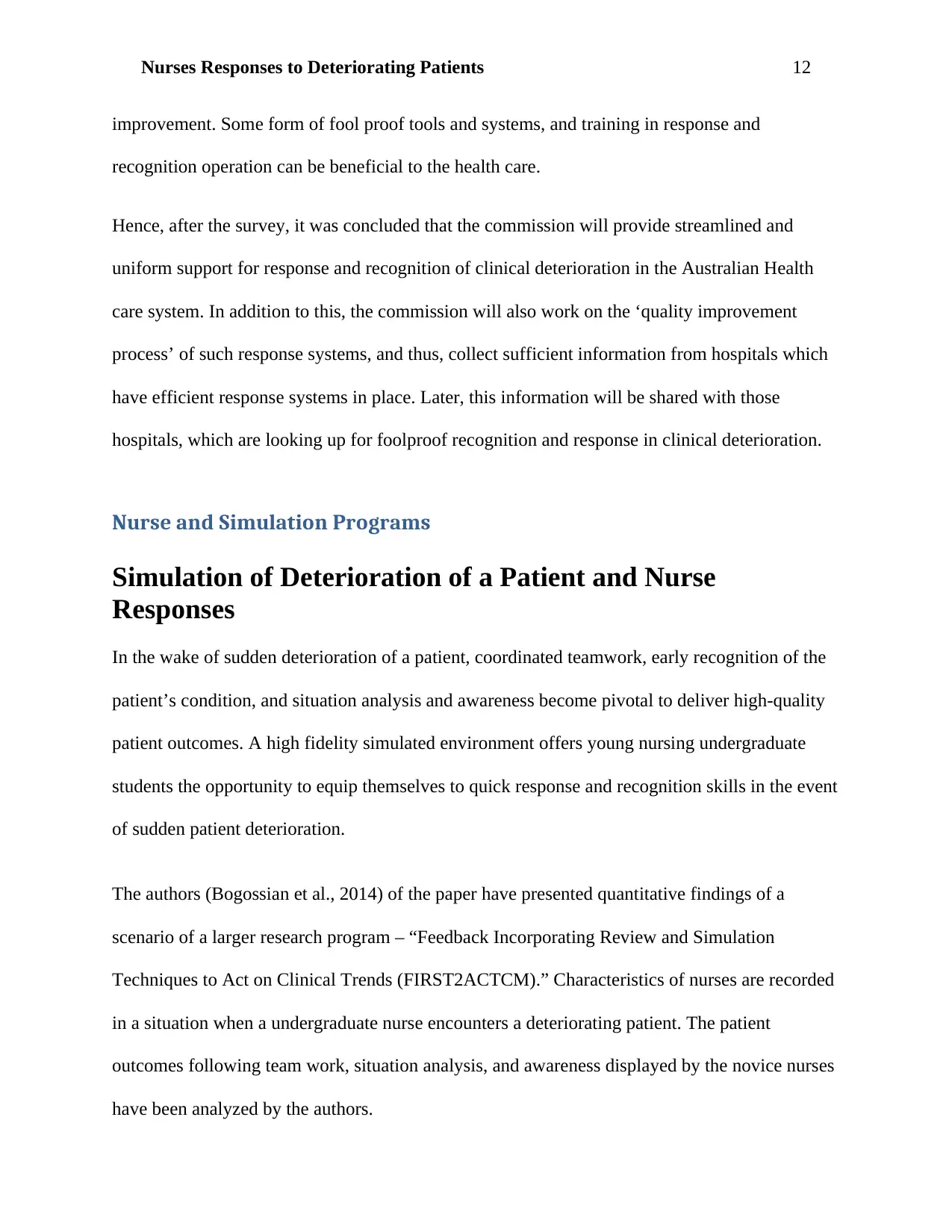
Nurses Responses to Deteriorating Patients 12
improvement. Some form of fool proof tools and systems, and training in response and
recognition operation can be beneficial to the health care.
Hence, after the survey, it was concluded that the commission will provide streamlined and
uniform support for response and recognition of clinical deterioration in the Australian Health
care system. In addition to this, the commission will also work on the ‘quality improvement
process’ of such response systems, and thus, collect sufficient information from hospitals which
have efficient response systems in place. Later, this information will be shared with those
hospitals, which are looking up for foolproof recognition and response in clinical deterioration.
Nurse and Simulation Programs
Simulation of Deterioration of a Patient and Nurse
Responses
In the wake of sudden deterioration of a patient, coordinated teamwork, early recognition of the
patient’s condition, and situation analysis and awareness become pivotal to deliver high-quality
patient outcomes. A high fidelity simulated environment offers young nursing undergraduate
students the opportunity to equip themselves to quick response and recognition skills in the event
of sudden patient deterioration.
The authors (Bogossian et al., 2014) of the paper have presented quantitative findings of a
scenario of a larger research program – “Feedback Incorporating Review and Simulation
Techniques to Act on Clinical Trends (FIRST2ACTCM).” Characteristics of nurses are recorded
in a situation when a undergraduate nurse encounters a deteriorating patient. The patient
outcomes following team work, situation analysis, and awareness displayed by the novice nurses
have been analyzed by the authors.
improvement. Some form of fool proof tools and systems, and training in response and
recognition operation can be beneficial to the health care.
Hence, after the survey, it was concluded that the commission will provide streamlined and
uniform support for response and recognition of clinical deterioration in the Australian Health
care system. In addition to this, the commission will also work on the ‘quality improvement
process’ of such response systems, and thus, collect sufficient information from hospitals which
have efficient response systems in place. Later, this information will be shared with those
hospitals, which are looking up for foolproof recognition and response in clinical deterioration.
Nurse and Simulation Programs
Simulation of Deterioration of a Patient and Nurse
Responses
In the wake of sudden deterioration of a patient, coordinated teamwork, early recognition of the
patient’s condition, and situation analysis and awareness become pivotal to deliver high-quality
patient outcomes. A high fidelity simulated environment offers young nursing undergraduate
students the opportunity to equip themselves to quick response and recognition skills in the event
of sudden patient deterioration.
The authors (Bogossian et al., 2014) of the paper have presented quantitative findings of a
scenario of a larger research program – “Feedback Incorporating Review and Simulation
Techniques to Act on Clinical Trends (FIRST2ACTCM).” Characteristics of nurses are recorded
in a situation when a undergraduate nurse encounters a deteriorating patient. The patient
outcomes following team work, situation analysis, and awareness displayed by the novice nurses
have been analyzed by the authors.
⊘ This is a preview!⊘
Do you want full access?
Subscribe today to unlock all pages.

Trusted by 1+ million students worldwide
1 out of 18
Related Documents
Your All-in-One AI-Powered Toolkit for Academic Success.
+13062052269
info@desklib.com
Available 24*7 on WhatsApp / Email
![[object Object]](/_next/static/media/star-bottom.7253800d.svg)
Unlock your academic potential
Copyright © 2020–2025 A2Z Services. All Rights Reserved. Developed and managed by ZUCOL.





